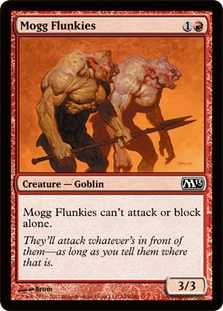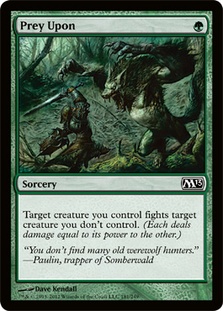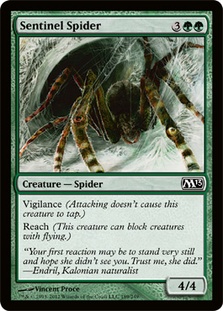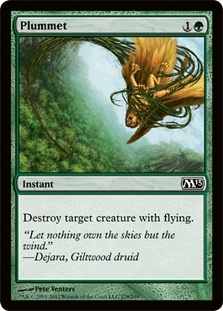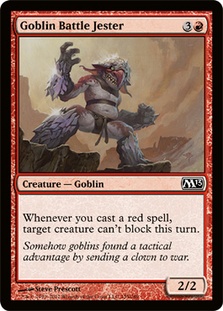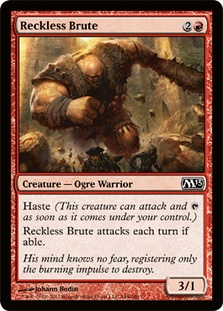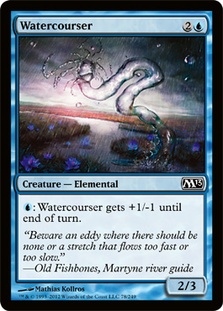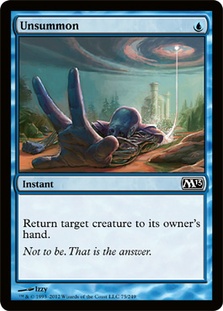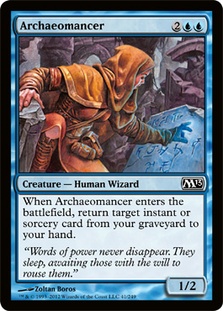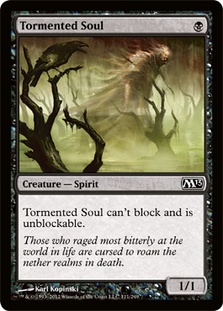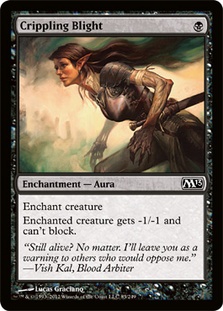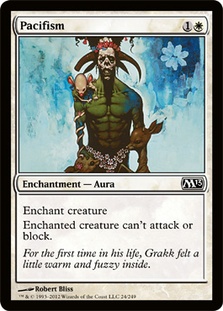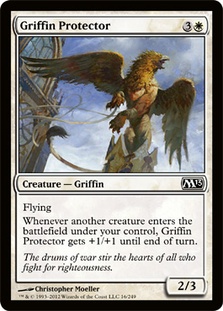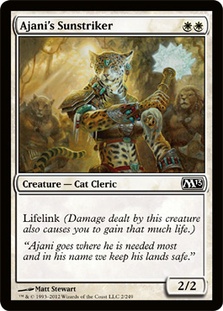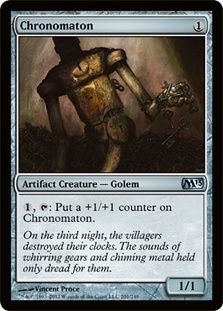I’ve done around 30 M13 Drafts online now, and I streamed most of them. I’ve found streaming is pretty useful for learning quickly, since it forces me to explain why I’m making the choices I’m making and lets me know when I’m doing something unexpected or which cards most people think I should care about. As a result, in addition to knowing which cards and strategies I think are good, I also know which I think are overrated or underrated based on the reactions of my viewers.
I’m feeling particularly confident in my understanding of M13 at the moment, so I felt like this would be a good time to write my one article on the subject.
A word of caution before we get to the details: I’m going to talk about the way I draft. It works and should be internally consistent, but I can’t guarantee that it’s the only way to draft, so you may have other findings that contradict what I’m saying. It’s entirely possible that a card that I never play is very good in an archetype that you’ve figured out how to make successful. If you know where a card works, don’t assume you have to stop drafting it just because I don’t.
These are the first questions people usually ask:
- "What’s the best color?"
- "What’s the best archetype?"
- "What should I avoid?"
The best color is green, the best archetype is Mogg Flunkies, and you should probably avoid blue and/or control decks unless you have some very powerful cards.
Now that you know the conclusion, let’s get to the explanation.
First of all, green.
There are two things going on here. The first is what green has, and the second is what the other colors don’t have.
Green has awesome creatures. Actually, green has awesome cards. Green normally has awesome creatures, and that hasn’t changed, but in addition to those awesome creatures it also has great spells. Plummet is a fantastic version of a spell that green gets a lot of different versions of, and Prey Upon is a new card to the core set that just fundamentally changes green’s place in the format.
Green used to worry primarily about tempo and utility creatures. Well, this set has no tapper, no pinger, no healer, no pumper, and no Aether Adept. There is no way to play a few creatures with tap abilities and lock green out of the game outside of rares (and potentially Arms Dealer, I guess), and even if your opponent has something like Arms Dealer or Intrepid Hero, you actually have an in-color out to it in Prey Upon. There are so many cards green decks have historically lost to in different Limited formats that just don’t exist here. Green has no natural predator in this format.
When you combine the lack of a natural predator with the fact that it gets a card that’s roughly as powerful as Air Elemental (at least) at common, the color really gets out of hand.
It’s hard to find theoretical reasons not to be green outside of opening good cards in other colors and the general dynamics of a draft. Fliers aren’t particularly scary when you have Deadly Recluse, Plummet, and Sentinel Spider, so what are you afraid of? Tormented Soul and exalted? I guess, but again, you have Prey Upon, the exalted creatures are pretty bad at blocking, and Elvish Visionary lets you chump a big guy for very little cost, so it can be pretty easy to just race some exalted creatures.
We live in a pretty backwards world where red might be the best reason not to want to be green, but if the point of green is to get things like a 3/3 for three, then it’s pretty embarrassing when red gets a 3/3 for two. And because green doesn’t have cheap removal (Prey Upon is too slow because you need to have a guy in play first) or early first strikers, Mogg Flunkies can generally attack early against green decks, Goblin Arsonist makes it hard to counterattack while you have an Arbor Elf in play, and Arms Dealer could just win a game. Moreover, red’s natural weakness to green’s high-toughness creatures is significantly mitigated by the fact that it gets Turn to Slag as one of its removal spells in addition to Bladetusk Boar and Goblin Battle Jester at four, two creatures with solid evasion that green’s anti-flier measures are hopeless against.
Red, like green, is unusually well positioned in the format as a whole. Turn to Slag is a clunky card, but it’s a nice out to have against big green monsters. Most of the time, the five-mana spell you’d rather cast is Chandra’s Fury, which is excellent in this format particularly because of small exalted creatures, but cards like Captain’s Call don’t hurt at all.
Red is the only color in the set that really rewards you for committing to a mono-color strategy, and here the rewards are in firebreathing with Dragon Hatching, Furnace Whelp, and occasionally Wall of Fire and in maximizing your Goblin Battle Jester triggers, which can be very relevant. Mono Red is a deck I’ve been very happy with in this format.
Mono Red, like B/R and G/R to me, is very much about maximizing the power of Mogg Flunkies, which is just amazing in this format thanks to a large number of playable one-mana creatures and Reckless Brute.
White and black feel about average to me in this format, with their most unusual characteristic being that they play well together for a change, but I’m skeptical of any enemy color deck in this format just because you don’t get any of the uncommon allied creatures, which are all excellent.
Blue feels underpowered, primarily in that I don’t often win with blue decks. All of this has been a "gut reaction" type analysis rather than based on actually counting playables and going over the cards in detail, which I think is worth doing now. I want to start with blue, as I’m particularly interested in discussing why it’s so weak here.
Each color has twenty commons. For blue, Merfolk of the Pearl Trident, Index, Mind Sculpt, and Hydrosurge are all essentially unplayable. Mind Sculpt has occasional uses, but those barely matter. I think we can all basically agree on that. Here’s where it gets more controversial: I’m not excited to play Harbor Serpent, Kraken Hatchling, Vedalken Entrancer, Welkin Tern, Wind Drake, Downpour, Negate, Encrust, or Tricks of the Trade.
For several of those, the first copy isn’t a problem, but I wouldn’t want very many. For Welkin Tern specifically, I think there are some decks where it’s very good, but that just doesn’t describe most of my blue decks.
That leaves Archaeomancer, Faerie Invaders, Scroll Thief, Water Courser, Divination, Essence Scatter, and Unsummon as the "good" blue commons.
Scroll Thief is pretty bad in this set unless you have exalted. It’s hard to push through and doesn’t block well. (Incidentally, the reason I don’t like Vedalken Entrancer is that the milling is too slow to matter unless you can really lock up the board, and the 1/4 is too small to matter against exalted and too slow to matter against Flunkies).
Watercourser is better than blue usually gets, but it’s not particularly better than Centaur Courser, Servant of Nefarox, Reckless Brute, or Attended Knight.
Unsummon is good. It’s particularly good in this set because there are playable expensive auras. Essence Scatter is just a solid card.
Archaeomancer is a great card, but it’s not what I want to be doing unless I have a lot of other awesome cards to buy time and to return with him. I think control is so hard to play in this format, largely because blue is so weak and particularly because four-toughness creatures, which blue usually relies on, aren’t good at stopping exalted. Divination is a normal, solid two-for-one. I’m happy to have it, but it’s not amazing. Finally, Faerie Invaders is a good size with a good ability, but people rarely actually run into it so it’s not that amazing. This color has a huge number of weak cards, and nothing that really stands out.
Blue essentially relies entirely on its uncommons. Fog Bank is the only card that reliably gives it time, and Talrand’s Invocation or Switcheroo with Archaeomancer are the best ways to take over the game.
Black, for comparison, has no commons that I’ve never had in my deck, I think. Walking Corpse, Zombie Goliath, Disentomb, Duress, Vile Rebirth, Dark Favor, and Bloodthrone Vampire are a little questionable, but they all have their spots. Bloodthrone Vampire is remarkably worse this time around than it ever has been before, so watch out for that.
Looking over the black commons, I’m reminded that one of the great things about this format is that every color has cards that are good in aggressive roles and different cards that are good if your deck is more controlling. Giant Scorpion and Tormented Soul can each be exactly what you want in some decks and unplayable in others. Crippling Blight is one of the best removal spells in the format if you’re aggressive but is pretty useless for some control decks—well, not useless since you still need to stop some early creatures, but narrow and not something you want a lot of.
One of the keys to black is knowing which and how many discard spells you want and when. It’s something of an art form, so I’m not really sure how best to explain it. The more attrition-based your deck is, the more you want them; the more aggressive your deck, the less you want them; and the more "all in" on auras or a few bombs, the more you want Duress. I guess that’s a reasonable summary.
Red’s only cards that I would never maindeck are Craterize and Smelt, although I don’t think I’ve played Wild Guess yet.
My most significant notes on red: Rummaging Goblin and Bladetusk Boar are, in my opinion, two of the most (if not the two most) overrated commons. Rummaging Goblin is just so much worse than the cards people want to compare it to, and it’s very slow and very much not what you should want to be doing. Bladetusk Boar is excellent, but I try to avoid it in my heavy red decks because I know that I won’t want too many things that cost four. I’d rather save room for Goblin Battle Jesters and Furnace Whelp unless it’s late in the draft and I know I’m short on four-drops. The surer I am that I don’t want Goblin Battle Jester, the more I like Bladetusk Boar. He’s particularly great in exalted decks, which are mostly white splashing red but could also be black splashing red. I like Mogg Flunkies enough that that’s not where I usually expect to find myself.
If I’m R/W I’d rather focus on Krenko’s Command, Captain’s Call, and Trumpet Blast.
As for green, the cards I try not to play are Bond Beetle, Bountiful Harvest, Ranger’s Path, Fog, and Serpent’s Gift. I could take or leave Yeva’s Forcemage, Vastwood Gorger, and Naturalize. Prey Upon, Arbor Elf, and Sentinel Spider are all very reasonable first picks, and Centaur Courser, Deadly Recluse, Titanic Growth, and other cards situationally are great.
I’ve already basically talked about why green is special in this set, so let’s move on.
White’s another color that’s very shallow. Guardian Lions, Pillarfield Ox, Silvercoat Lion, War Falcon, Warclamp Mastiff, Captain’s Call, Angel’s Mercy, Erase, Glorious Charge, and Divine Favor make up a full half of white’s cards that range from unexciting to unplayable. Only Pacifism, Aven Squire, Attended Knight, and Griffin Protector really stand out, though Guardians of Akrasa and Ajani’s Sunstriker are certainly not bad.
That’s it for the commons.
People often ask about the Rings. I think they’re not as different from each other as people make them out to be. They’re all very good if you have enough (~8) creatures of their color, especially if your deck can lead to long games. Chronomaton gets an honorable mention for being my hero. It basically has to be one of the most underrated cards in the set because it’s almost impossible to have too high an estimation of it.
Finally, I just want to go over the cards that I over or underrate compared to people I draft against as determined by the numbers—the cards that I own the most and least of.
The numbers after the cards will be the number I have on my Magic Online account. These are the cards I have more of than average:
White: Aven Squire (18), War Falcon, Glorious Charge, Safe Passage (17)
Blue: Divination (18), Archaeomancer (17), Unsummon (16)
Black: Crippling Blight (16), Mark of the Vampire (15)
Red: Mogg Flunkies (23), Volcanic Strength (20), Krenko’s Command (19), Goblin Battle Jester, Chandra’s Fury, Kindled Fury, Trumpet Blast (17), Smelt (15)
Green: Arbor Elf (23), Centaur Courser, Fog, Naturalize (19), Sentinel Spider (18), Spiked Baloth, Prey Upon (17), Serpent’s Gift, Titanic Growth (15)
Land: Evolving Wilds (16)
Data is low on uncommons, but I have fifteen Chronomatons, which is three more than my next highest card.
Cards that I have relatively few of:
White: Pacifism (7), Divine Favor, Divine Verdict (6), Captain’s Call (3)
Blue: Wind Drake (6), Scroll Thief, Welkin Tern, Mind Sculpt, Encrust (5)
Black: Liliana’s Shade, Walking Corpse (5)
That’s my analysis of M13. Be aggressive, be R/G, or at least try to be one of those colors, and try to avoid blue.
Thanks for reading,
Sam
@samuelhblack on Twitter

